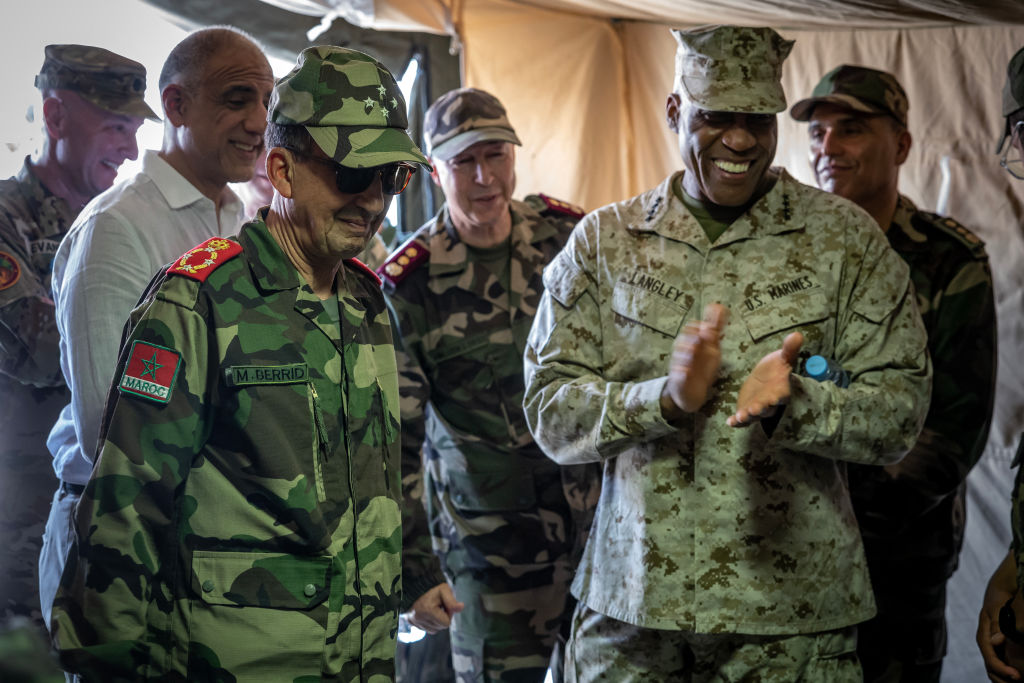ADF STAFF
A member of the Libyan Armed Forces looked across the vast desert in Ben Ghilouf, Tunisia, and watched a military helicopter obliterate a ground target. As smoke billowed, he confirmed the target’s destruction over a large radio and watched the helicopter fly away.
The LAF member was one of 8,000 participants from 27 countries who participated during the 20th annual African Lion military exercise hosted in Ghana, Morocco, Senegal and Tunisia between April 20 and May 31. The aim of exercise African Lion is to bolster defense capabilities and foster interoperability among participating nations.
In Dodji, Senegal, exercises included combined infantry tactics and a medical exchange led by the U.S. Marine Forces Reserve. The exercise also provided an opportunity for local communities to engage with visiting forces to help strengthen civil-military relations.
In Dodji, Senegal, exercises included combined infantry tactics and a medical exchange led by the U.S. Marine Forces Reserve. The exercise also provided an opportunity for local communities to engage with visiting forces to help strengthen civil-military relations.

“The exercise was a resounding success,” Armed Forces of Senegal (SAF) Col. Theodore Adrien said. “We’ve enhanced interoperability and cemented our role as leaders of strategic importance in the region.”
Also in Senegal, the Royal Netherlands Army and the SAF completed combat lifesaver exchange training led by U.S. Navy Cmdr. Evelyn Palm, a Ghana native.
“These sessions led by Cmdr. Palm are crucial,” Sgt. Serigne Kosso Samb, an SAF firefighter, said. “The techniques and tools were clear, convenient and relevant to help take care of casualties under fire.”
Other joint training exercises focused on field hospital operations, medical evacuations and humanitarian assistance. Emphasized throughout the exercise was a whole-of-government approach to address the root causes of instability, rather than just focusing on military might.
Ghana Armed Forces Lt. Roland Nettey, a public relations officer, said he participated in a civilian-military operations course, similar to the exercise in Senegal.
“We learned how to go down to the grassroots, the locals, to inquire about the things they need and how we can meet them halfway as a military,” Nettey said. “We believe that when you engage the locals, you learn exactly what they need, and you learn more about the demographics of the locals. … This exercise has been helpful, it helps us communicate with international [militaries] and boost bilateral ties with our United States counterparts, especially.”

During the exercise, Ghanaian and U.S. troops participated in a medical civic action program in Damongo, in the country’s grassy woodland Savannah region, where they offered medical services to locals.
Ghana Armed Forces Maj. Senyo Dzamefe, a battery commander, attended African Lion last year and said this year’s training also offered fresh perspectives on military planning operations.
“This year, we are seeing the interoperability between the Army and Special Forces playing out well,” Dzamefe said. “We tell [exercise leaders] what we are trying to do, and they tell their view of it.”
In southwest Morocco’s Tan-Tan region, Abrams tanks and armed Soldiers in pickups tore across the desert in a range of maneuvering exercises. Generals from the U.S. and Morocco also observed live-fire bombing demonstrations and celebrated Africa Lion’s 20-year anniversary.
“This exercise has grown over the years since 2004,” Gen. Michael Langley, head of the U.S. Africa Command, told The Associated Press. “Not only have the number of multinational service members that we train with [increased], but also the scope of the training as well, which has expanded to more than just security.

